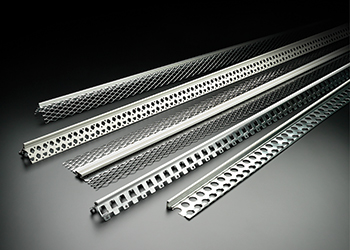Quality key to success
01 February 2017
RICHARD PRICE, technical director at Catnic, a British manufacturer of steel building components, elaborates on how to achieve optimal results with plaster as a building finish.
Buildings across the Gulf region share a distinctive style that often relies on the smooth, pristine effect of a high quality plaster finish blended with other modern materials such as metal and glass. It is therefore plaster, in part, which helps to bestow the area with its distinctive architectural aesthetic.
The exterior finish of any building performs two functions. Firstly it protects the surface of the building envelope against the elements. Secondly it provides a decorative finish that enhances the appearance of the building.
When it is applied professionally, a good plaster or skimmed finish will protect the structure of the building from exposure, acting as a waterproofing sealant and a sanitary coating for the building to prevent the ingress of vermin and insects. It works too as a levelling coat, making both external walls and internal walls and ceilings smooth for their own aesthetic appeal, or as a base for the application of paint or other decorative treatments. In addition, it provides a preliminary defence against fire and so also plays a role in helping to fireproof a building.
Despite correct maintenance, all too often a plaster or rendered finish can fail long before the lifetime of the building due to errors in the specification of important details. For example, plasterers’ beads may be considered commodity products, necessary to ‘get the job done’ and therefore left to sub-contractor discretion. This creates the risk of cost-cutting and potential quality compromise, yet they are a reliable method of achieving the high standard, sustainable finish that clients expect.
The right bead helps to achieve a neat, crisp and professional finish while also avoiding cracking and splitting, which can cause issues with the paintwork or wall coverings at a later date. Therefore, the accurate specification of these components is integral to the long-term performance of the building envelope.
Catnic beads and plastering profiles are now increasingly being specified by name, instead of the ‘equal or equivalent to’ approach of the past. It means there is no room for interpretation or misjudgement when it comes to ensuring only the highest quality beads are used to achieve the best possible plaster finishes.
By specifying a brand, right down to the type of plasterers’ beads to be used in the internal and external finishes of a building, the specifier is safeguarding his own design intent.
A good bead is one manufactured from a thicker gauge of steel, providing rigidity and strength, helping to ensure a straight edge and slick precision finish. These properties will also ease site logistics because a strong, straight bead is faster and easier to install, helping to reduce time on site, limiting snagging and improving labour costs too.
Catnic’s galvanised beads are manufactured to a gauge 11 per cent above the requirements of both British and European standards, while its stainless steel beads exceed these requirements by 25 per cent.
In specifying such a product by its brand name, architects can ensure that beads with adequate protection are installed and the overall finish of a rendered façade is secured for the long term.
A well-made bead provides the right depth, helping to ensure the correct level of plaster is applied and, therefore, stopping the bead from showing through the finish. Punching and forming also needs to be of a consistently high standard and should comply with BS EN 13658-1:2005 and BS EN 14353:2007 as a mark of quality. It is also worthwhile selecting products in line with BS EN 13914 Parts 1 and 2: 2005, which provide guidance on the design, preparation and application of external rendering and internal plastering.
The high temperatures of the Gulf region, combined with humidity, sand and airborne salinity all conspire to create a harsh environment for buildings and their materials. Here the advice of a manufacturer experienced in the specification of metal building products can prove invaluable. Galvanised steel beads should be used internally and stainless steel or PVCu (unplasticised polyvinyl chloride) should be installed externally. For areas of high moisture or in very damp conditions, stainless steel or PVCu are equally suitable.
In particular, PVCu beads should be selected for projects situated in the most aggressive climatic conditions. These can be specified for situations where galvanised beads are not recommended and internally in areas where high moisture or damp exists, in both cases providing an economical alternative to stainless steel.
- Bamardouf builds brand image
- Leister helps tackle the task
- Henkel solutions get good response
- Quality key to success



